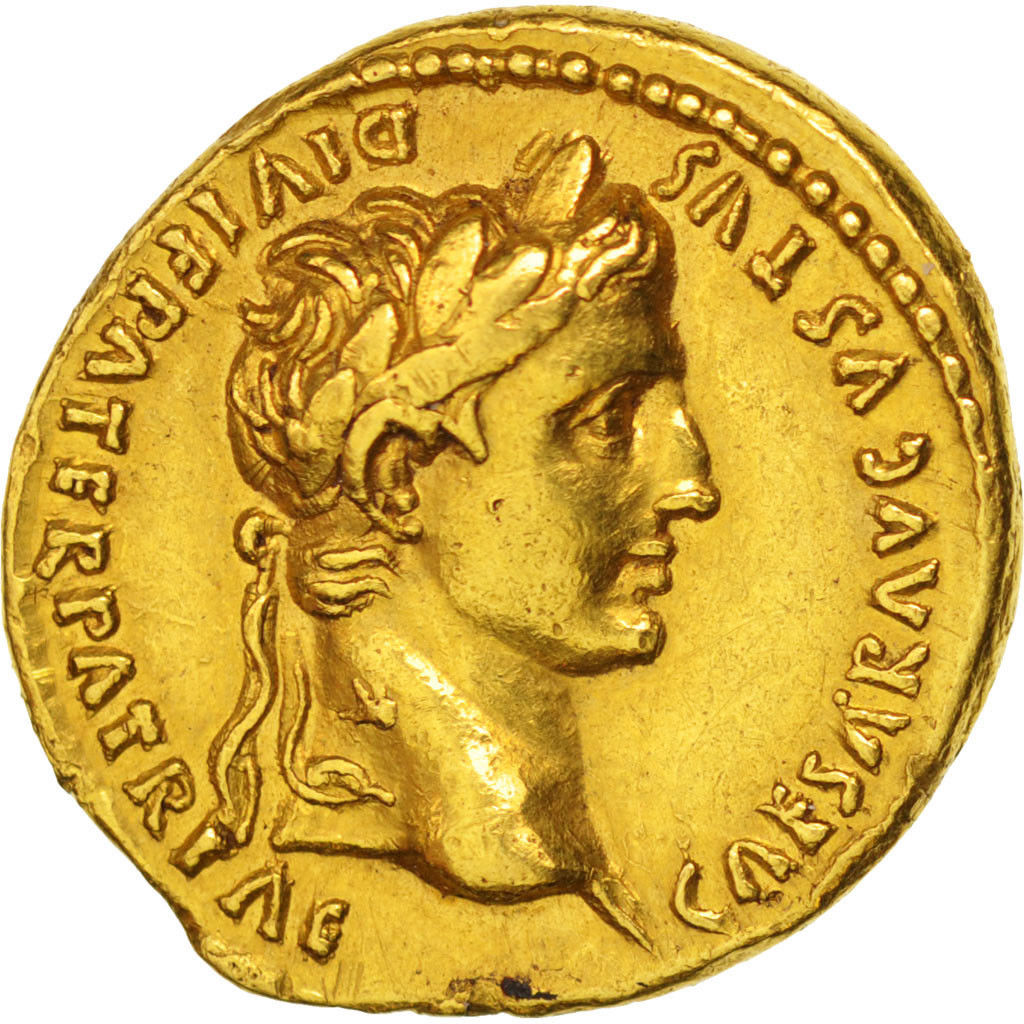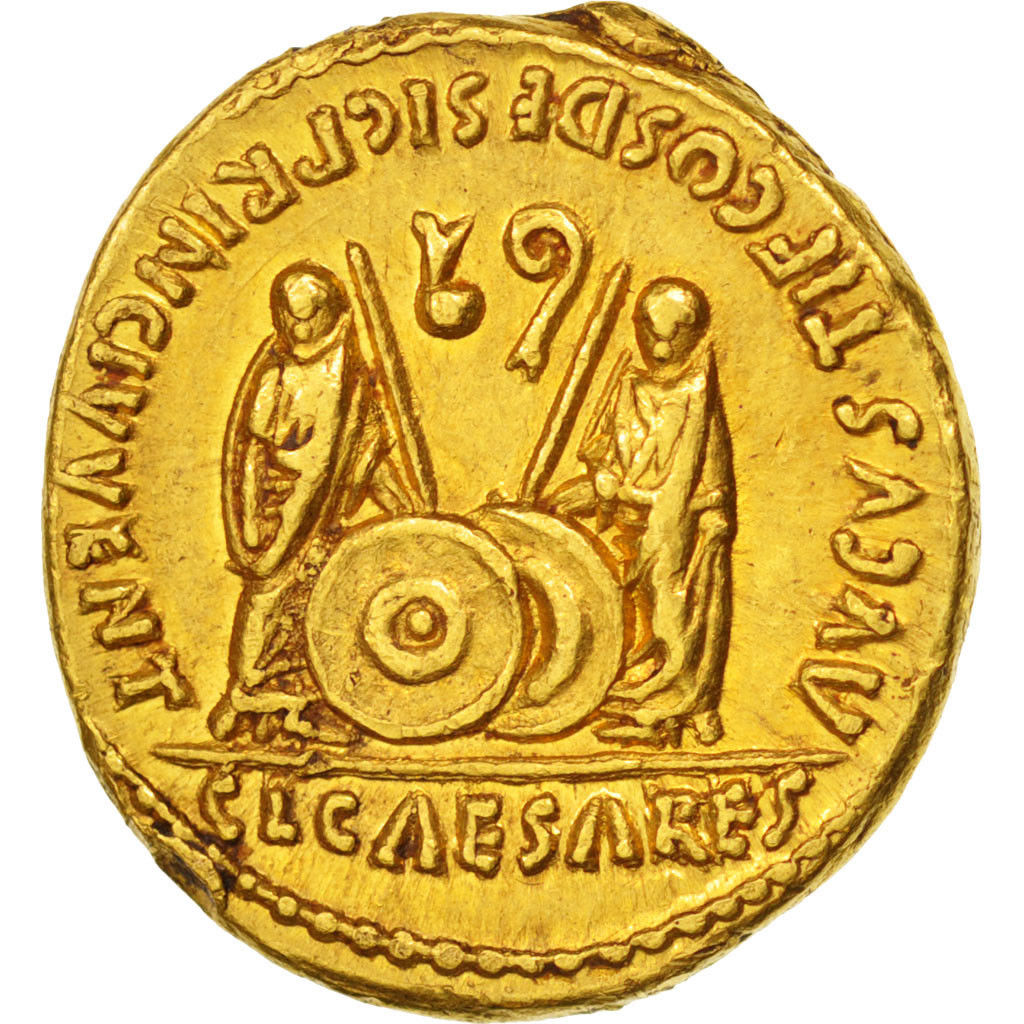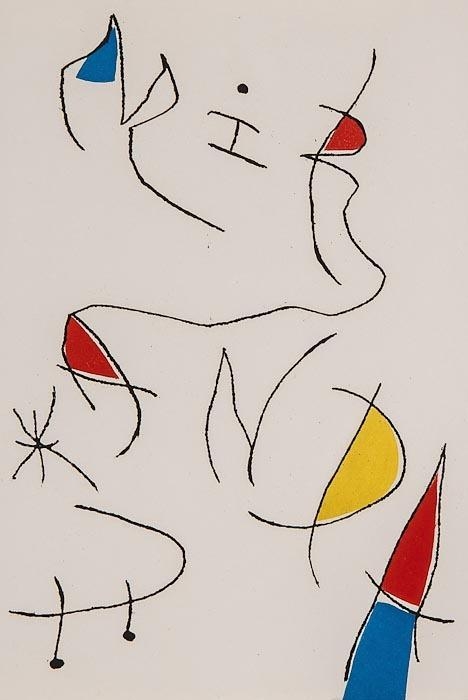Notes: Laureate head right /
Gaius & Lucius standing front, each togate and with a hand resting on a round shield, a spear, and in field above, a simpulum right & lituus left.
This coin, issued by the Emperor Augustus, was issued to promote the status of his two grandsons, Gaius and Lucius. He wished them to be his heirs and appointed them Princeps Juventutis.
This coin, issued by the Emperor Augustus, was issued to promote the status of his two grandsons, Gaius and Lucius. He wished them to be his heirs and appointed them Princeps Juventutis.
Obverse: Augustus (23 September 63 BC – 19 August 14 AD) was the founder of the Roman Empire and its first Emperor, ruling from 27 BC until his death in AD 14. He took power after defeating Mark Antony at Alexandria on August 1, 30BC (following the Battle of Actium in 31 BC. Following the defeat of Antony, he spent the next three years setting up the legal structure for the Empire and formally took the title Augustus, transforming the Republic into the Principate and taking direct control of most of the Provincial legions.
Throughout his rule, Augustus focused on both stabilizing the Empire (which was in disarray due to the severity and frequency of civil wars preceding his ascesion to power) as well as consolidating control of the army and legislature under his personal direction.
On 19 August AD 14, Augustus died while visiting Nola where his father had died. Both Tacitus and Cassius Dio wrote that Livia was rumored to have brought about his death by poisoning fresh figs. This element features in many modern works of historical fiction pertaining to his life, but some historians view it as likely to have been a salacious fabrication made by those who had favoured Postumus as heir, or other of Tiberius' political enemies. Livia had long been the target of similar rumors of poisoning on the behalf of her son, most or all of which are unlikely to have been true.
Throughout his rule, Augustus focused on both stabilizing the Empire (which was in disarray due to the severity and frequency of civil wars preceding his ascesion to power) as well as consolidating control of the army and legislature under his personal direction.
On 19 August AD 14, Augustus died while visiting Nola where his father had died. Both Tacitus and Cassius Dio wrote that Livia was rumored to have brought about his death by poisoning fresh figs. This element features in many modern works of historical fiction pertaining to his life, but some historians view it as likely to have been a salacious fabrication made by those who had favoured Postumus as heir, or other of Tiberius' political enemies. Livia had long been the target of similar rumors of poisoning on the behalf of her son, most or all of which are unlikely to have been true.
Denomination: The aureus (pl. aurei - "golden") was a gold coin of ancient Rome valued at 25 silver denarii. The aureus was regularly issued from the 1st century BC to the beginning of the 4th century AD, when it was replaced by the solidus. The aureus was about the same size as the denarius, but heavier due to the higher density of gold (as opposed to that of silver.)
Before the time of Julius Caesar the aureus was struck very infrequently, usually to make large payments from captured booty. Caesar struck the coin more frequently and standardized the weight at 1/40 of a Roman pound (about 8 grams). Augustus (r. 29 BC - 9 AD) tariffed the value of the sestertius as 1/100 of an aureus. The mass of the aureus was decreased to 1/45 of a pound (7.3 g) during the reign of Nero (r. 54 - 68).
After the reign of Marcus Aurelius (r. 161 - 180) the production of aurei decreased, and the weight was further decreased to 1/50 of a pound (6.5 g). During the 3rd century, gold pieces were introduced in a variety of fractions and multiples, making it hard to determine the intended denomination of a gold coin.
From Wikiepedia
Before the time of Julius Caesar the aureus was struck very infrequently, usually to make large payments from captured booty. Caesar struck the coin more frequently and standardized the weight at 1/40 of a Roman pound (about 8 grams). Augustus (r. 29 BC - 9 AD) tariffed the value of the sestertius as 1/100 of an aureus. The mass of the aureus was decreased to 1/45 of a pound (7.3 g) during the reign of Nero (r. 54 - 68).
After the reign of Marcus Aurelius (r. 161 - 180) the production of aurei decreased, and the weight was further decreased to 1/50 of a pound (6.5 g). During the 3rd century, gold pieces were introduced in a variety of fractions and multiples, making it hard to determine the intended denomination of a gold coin.
From Wikiepedia
Period: Imperial Rome. As the Roman Republic began to implode because of
corruption and infighting among powerful members of the Roman Senate, a new type of
Roman Republican coinage emerges, that of the military strongmen who dominated and
fought among each other before the final fall of the Republic. The drama surrounding
the fall of the Roman Republic is a story full of political intrigue, military action, betrayal,
murder and sex scandals. Different parts of this story have been told and retold by
ancient historians, modern day scholars, dozens of Hollywood movies and even an HBO
miniseries. All of the actors in this great drama, Crassus, Pompey, Julius Caesar, Brutus
and Cassius, Mark Antony and Cleopatra and the last man standing at the end of it all,
Octavian (later known as the first emperor of Rome, Emperor Augustus) all minted coins
during this time bearing their names and propaganda images supporting their factions
and political ideals.
Culture: Ancient Rome. A famous catch phrase "Rome was not built in a day"
definitely applies to the Roman civilization. Rome stated as a series of small villages among the
famous seven hills of Rome along the river Tiber. Eventually through conquest, diplomacy, wise
policies of indirect rule and assimilation, the Romans were able to not only unify the Italian
peninsula, but though a series of brutal wars against regional powers established a great Empire
that spanned Europe, Asia and Africa, making the Mediterrean Sea and "Roman Lake."
All Roman coinage can generally be divided into eight time periods as described below. An interesting thing about Roman coins minted during these eight time periods is that you can literally see the "Rise and Fall" of the Roman Empire on its coinage as the sharp imagery and pure silver and gold coins of the Roman Republic and Early Imperial Period gradually devolves into crude, illegible and heavily debased coins of the "Barracks Emperors" and "Barbarian" Period.
All Roman coinage can generally be divided into eight time periods as described below. An interesting thing about Roman coins minted during these eight time periods is that you can literally see the "Rise and Fall" of the Roman Empire on its coinage as the sharp imagery and pure silver and gold coins of the Roman Republic and Early Imperial Period gradually devolves into crude, illegible and heavily debased coins of the "Barracks Emperors" and "Barbarian" Period.
Item created by: George on 2016-08-12 07:48:02. Last edited by gdm on 2016-08-12 15:58:55
If you see errors or missing data in this entry, please feel free to log in and edit it. Anyone with a Gmail account can log in instantly.
If you see errors or missing data in this entry, please feel free to log in and edit it. Anyone with a Gmail account can log in instantly.








